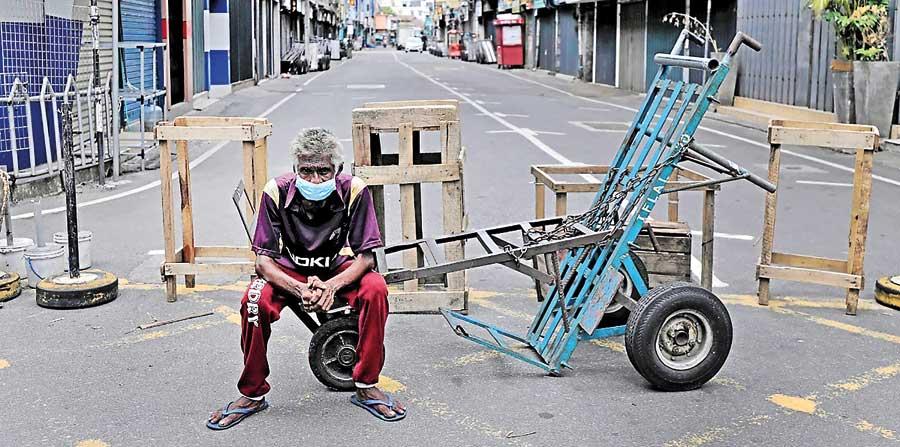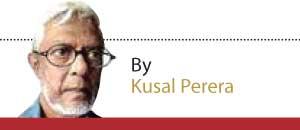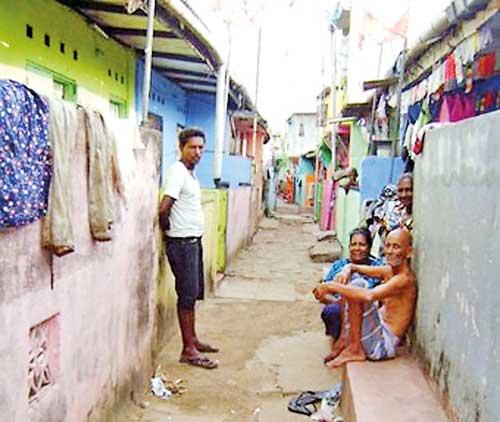16 Nov 2020 - {{hitsCtrl.values.hits}}
In 2016 within Colombo Municipality limits there were 1,735 extremely poor cluster settlements

A labourer sits on a cart in a street with closed shops near the main market in Colombo REUTERS
The COVID-19 pandemic has a devastating effect on Colombo life, with the continuing second wave and the Peliyagoda wholesale fish market exploding with a quick spread of the virus even beyond Colombo. 
With Colombo city grabbed by the pandemic with less mercy, the Government was compelled to isolate and lockdown Mattakkuliya, Muttwal, Bloemendhal, Kotahena, Grandpass, Foreshore Police area, Aduruppu Street, Maligawatte, Dematagoda, Keselwatte and Borella, all within the Colombo Municipal city limits and then Wellampitiya bordering Dematagoda. Latest numbers account for 82 police personnel from the Fort police station alone, and according to the Chief Medical Officer of Health (CMoH) of the Colombo Municipal Council (CMC), there are 2,850 confirmed positive cases within Colombo city limits.
Colombo city was never a planned city. It just grew over a period of hundreds of years from the Colonial period around the “Colombo jetty” as it was then called, and the “harbour” later and now the Colombo port. In popular lingo, Colombo is the centre of power politics and elite life. The common understanding is Colombo belongs to the urban middle-class. They do, as the most active city consumer. But what is the profile of the Colombo City like?
Not very much different to now, in 2016 within Colombo Municipality limits there were 1,735 extremely poor cluster settlements. In the 1950s and 1960s, they were called “Mudukku” in Sinhala borrowed from Tamil “Mudukku” and “slums and shanties” in English. They were often identified with thuggery, pick-pocketing, moonshine and everything that can be called ‘evil’.
Since the late 1970s, communities in these settlements got absorbed into the informal economic sector that developed in and around Colombo city within the open market economy that provided numerous income opportunities to them, though with undefined sources.
From the late 1980s these “slums and shanties” came to be termed “Under-Served Settlements” (USS), the reason being their change in lifestyle with aspirations for social mobility and small but conspicuous changes they effected to the structures of their abodes giving them some permanency.
"Whatever the new strain is or however common it is, laboratory research and academic studies will not answer why Colombo city alone had to isolate over 11 areas as “high-risk areas”, while the total number of isolated areas in the whole country remains at 28 (as of 10 Nov)"
These USS have a population of around 650,000 in them. Their concentration in the City is in Colombo North, Central and Borella/Dematagoda area that has 1,544 USS. Of the total USS in the Colombo city:
(Source – Sevanatha field survey 2016)
This is summed up in plain language by the Urban Development Authority (UDA) in introducing their “Urban  Regeneration Programme”. The first two sentences in the opening paragraph say, “Over fifty percent of the Colombo city population lives in shanties, slums or dilapidated old housing schemes, which occupied nine percent of the total land extent of the city. A survey which is being conducted at present by the Urban Development Authority has identified a total number of 68,812 families living in 1,499 community clusters (underserved settlements) which do not have a healthy environment for human habitation and access to basic infrastructure facilities such as clean water, electricity, sanitation etc.” (Accessed 10 November uda.gov.lk/urban-regeneration-programme.html)
Regeneration Programme”. The first two sentences in the opening paragraph say, “Over fifty percent of the Colombo city population lives in shanties, slums or dilapidated old housing schemes, which occupied nine percent of the total land extent of the city. A survey which is being conducted at present by the Urban Development Authority has identified a total number of 68,812 families living in 1,499 community clusters (underserved settlements) which do not have a healthy environment for human habitation and access to basic infrastructure facilities such as clean water, electricity, sanitation etc.” (Accessed 10 November uda.gov.lk/urban-regeneration-programme.html)
What needs to be kept in mind is that half the resident city population live in USS. That allows for an understanding how confirmed COVID-19 related deaths reported on 5 October, had 4 out of 5 from Colombo 2, 12, 14 and 15 while the fifth was from adjoining Wellampitiya. Of the 41 deaths to date, nearly half were from Colombo city. The rate of confirmed positive cases in Colombo also has an alarming increase compared to other districts.
This heavy spike is attributed to a new mutated strain with high transmissibility according to a sequencing study of the COVID-19 virus carried out by a specialised team of academics at the Sri Jayawardenapura University, headed by Prof Neelika Malavige. She affirms, this is seen in about 97 percent of the strains, and is nothing new. (DM – 10 Nov)
Whatever the new strain is or however common it is, laboratory research and academic studies will not answer why Colombo city alone had to isolate over 11 areas as “high-risk areas”, while the total number of isolated areas in the whole country remains at 28 (as of 10 Nov).
Northern and Central Colombo have all the declared isolated areas and have the largest concentration of USS in the city. Also, these parts of the city are more densely populated than the rest of Colombo city. There is obviously a direct relationship between heavy infection in these areas and the presence of large numbers of USS.
Large numbers of USS in areas declared as “isolated” in the city that “do not have a healthy environment for human habitation and access to basic infrastructure facilities” as the UDA says with half the city population, cannot by any chance afford to maintain social distancing and even sanitizers for regular hand-washing. Their daily cramped living not only in their abodes but also within under-served settlements don’t allow them the luxury of social distancing. Lack of or inadequate water service denies them any opportunity of regular hand-washing even without sanitizers. Compelled to wear a face mask, they go for the cheapest that serves little purpose in wearing in terms of COVID-19 prevention. That is the plight of half the city population.
The other important but rarely counted factor is their total dependence on a daily earned income. Since the first wave from March when the whole country was locked down for almost 02 months, they were left in a heavily shrunk informal urban economy from which they made a meagre living. Now it is impossible to keep them locked down without an income for indefinite periods. All who could venture out would go about searching for a living. In short, these heavily populated areas with USS in the Colombo city cannot be isolated as any middle-class apartment or housing scheme could be isolated. These marginalised communities left desperate for an income would continue to violate restrictions and isolation in a bid to earn an income, come what may.
Thus, the government needs to have a completely different package for these marginalised urban communities in controlling COVID-19 spread. As claimed by the CMoH Colombo, going by random tests done there could be around 5% affected persons in the city by now. It should therefore be stressed, once the locally isolated area lockdowns are over, the USS residents would be hastily going around looking for daily income and thus could become “asymptomatic carriers” of the virus into other neighbouring areas. This applies to other large cramped resident areas too around Katunayake, Biyagama, Avissawella export promotion zones and most importantly to the upcountry plantation community, if COVID-19 travels that far. They all need area-specific special packages for COVID-19 prevention and control.
"Without clear planning for different social contexts and for marginalised communities, blanket instructions on social distancing and using sanitizers for handwashing meant for the urban middle-class will not serve in controlling this pandemic as the present spread reveals quite clearly"
Though late, at least for future replication we need to have a special welfare package designed and carried through the CMoH of the Colombo Municipal Council and his staff as a starter for these marginalised communities in presently isolated areas. They should be served with:
Without clear planning for different social contexts and for marginalised communities, blanket instructions on social distancing and using sanitizers for handwashing meant for the urban middle-class will not serve in controlling this pandemic as the present spread reveals quite clearly. There certainly is a “class factor” in this spread for any sociologist or poverty analyst to study. That too would be contributory in controlling this COVID-19 spread, as most in the health sector believe we would have to live with it for a year or two to come.
30 Nov 2024 3 hours ago
30 Nov 2024 4 hours ago
30 Nov 2024 7 hours ago
30 Nov 2024 9 hours ago
30 Nov 2024 30 Nov 2024